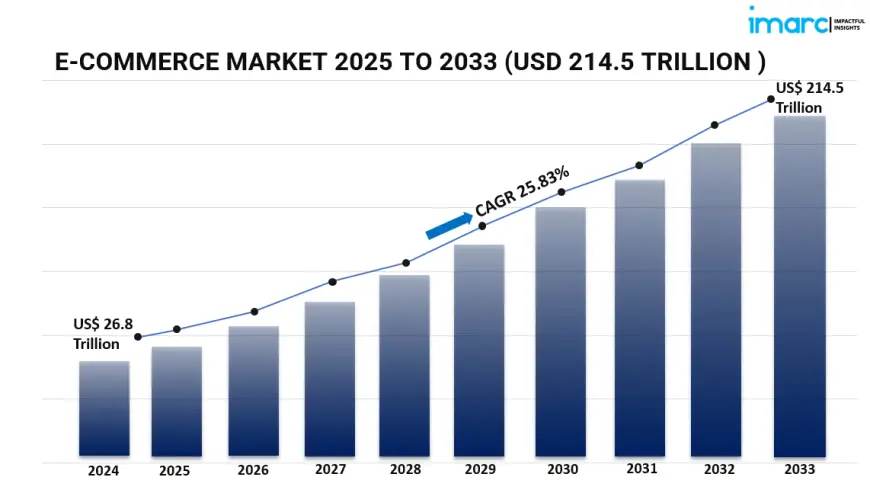Global E-Commerce Market: Trends, Innovations, and Growth Opportunities

E-Commerce Market Overview
The global e-commerce market is experiencing unprecedented expansion, fueled by cutting-edge technologies, growing cross-border trade, and the rapid adoption of digital payment methods. Valued at USD 26.8 trillion in 2024, the market is anticipated to soar to USD 214.5 trillion by 2033, representing a robust CAGR of 25.83% during 2025–2033. This remarkable growth is driven by the rising use of mobile devices, enhanced internet connectivity, and evolving consumer preferences for seamless, mobile-first shopping experiences.
Study Assumption Years
Base Year: 2024
Historical Years: 2019–2024
Forecast Years: 2025–2033
E-Commerce Market Key Takeaways
- Market expected to rise from USD 26.8 trillion in 2024 to USD 214.5 trillion by 2033, at a CAGR of 25.83%.
- Asia Pacific continues to dominate due to urban growth and increasing smartphone usage.
- AI and ML integration is enhancing personalized experiences and improving customer satisfaction.
- Secure digital payments are reshaping consumer trust and convenience in online transactions.
- Cross-border e-commerce is expanding, providing global access to diverse products.
- Growing emphasis on sustainable packaging and ethical sourcing.
- The surge of mobile commerce (m-commerce) is making shopping more flexible and user-friendly.
? Request a sample copy of the report:
https://www.imarcgroup.com/e-commerce-market/requestsample
Market Growth Drivers
1. Technological Advancements
The e-commerce industry is evolving with innovations in augmented reality (AR), artificial intelligence (AI), and machine learning (ML). AR-powered virtual try-on features and AI-driven personalized recommendations are enhancing user engagement and reducing return rates. These technologies enable businesses to offer tailored shopping experiences and gain deeper insights into consumer behavior.
2. Regulatory Landscape
Shifting regulations related to data privacy, consumer protection, and fair trade are supporting the expansion of global e-commerce. Such frameworks not only build consumer trust but also encourage cross-border trade, unlocking new growth opportunities for online retailers. Adherence to these evolving regulations is expected to foster healthy competition and innovation.
3. Rising Market Demand
E-commerce has become integral across all demographics, driven by the demand for convenience and time efficiency. Features like fast delivery, wide product selection, and competitive pricing are strengthening customer loyalty. Additionally, traditional retailers are embracing digital platforms, further reinforcing the global e-commerce ecosystem.
Market Segmentation
By Type:
- Home Appliances – Digital platforms for household electrical goods.
- Apparel, Footwear, and Accessories – Online availability of fashion, footwear, and accessories.
- Books – Sale of both physical and digital book formats.
- Cosmetics – Online distribution of skincare, makeup, and beauty products.
- Groceries – E-commerce delivery of daily essentials and food products.
- Others – Various other product categories available online.
By Transaction:
- Business-to-Consumer (B2C) – Companies selling directly to customers.
- Business-to-Business (B2B) – Transactions between corporate entities.
- Consumer-to-Consumer (C2C) – Platforms facilitating peer-to-peer sales.
- Others – Alternative digital transaction models.
Breakup by Region
- North America: United States, Canada
- Asia Pacific: China, Japan, India, South Korea, Australia, Indonesia, Others
- Europe: Germany, France, United Kingdom, Italy, Spain, Russia, Others
- Latin America: Brazil, Mexico, Others
- Middle East and Africa
Regional Insights
Asia Pacific remains at the forefront of the global e-commerce market, fueled by urbanization, widespread smartphone usage, and robust internet infrastructure. Countries such as China and India are witnessing significant growth in online shopping due to platform convenience and extensive product variety.
Recent Developments & News
The e-commerce landscape continues to evolve with technological innovation and global collaboration. For instance, Zalando introduced AI-powered virtual fitting rooms using 3D avatars, elevating customer experiences. Furthermore, advancements in secure cross-border payment solutions are driving safer, more inclusive digital transactions, supporting the market’s sustained growth trajectory.
Key Players
- Alibaba Group Holding Limited
- Amazon.com Inc.
- Apple Inc.
- B2W Companhia Digital (Lojas Americanas S/A)
- eBay Inc.
- Groupon Inc.
- Rakuten Group, Inc.
- Walmart Inc.
- Zalando SE
If you require any specific information that is not covered currently within the scope of the report, we will provide the same as a part of the customization.
Ask Analyst for Customization: https://www.imarcgroup.com/request?type=report&id=2243&flag=C
About Us
IMARC Group is a global management consulting firm that helps the world’s most ambitious changemakers to create a lasting impact. The company provides a comprehensive suite of market entry and expansion services. IMARC offerings include thorough market assessment, feasibility studies, company incorporation assistance, factory setup support, regulatory approvals and licensing navigation, branding, marketing and sales strategies, competitive landscape and benchmarking analyses, pricing and cost research, and procurement research.
What's Your Reaction?
 Like
0
Like
0
 Dislike
0
Dislike
0
 Love
0
Love
0
 Funny
0
Funny
0
 Angry
0
Angry
0
 Sad
0
Sad
0
 Wow
0
Wow
0

















































